 |
The Saint of the Day
Blessed Osanna of Mantua - June 18
Prof. Plinio Corrêa de Oliveira
Biographical selection:
Osanna Andreasi was born on January 17, 1449 in Carbonarola, close to Mantua, in the magnificent palace of a very noble Italian family that originated in Hungary. Later the family moved to a smaller palace in Mantua. At age 5, while walking along the banks of the Po River, she heard a clear, firm voice that told her: “Life and death consist in loving God.” She entered into an ecstasy and was raised to Heaven by a splendorous Angel. He showed her the celestial hierarchy and told her, “To enter Heaven it is necessary to love God very much: See how all created things sing His glory and proclaim it to men.”
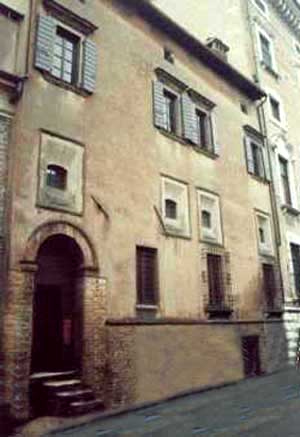
Partial view of the Andreasi palace in Mantua; below, arches and garden in the courtyard
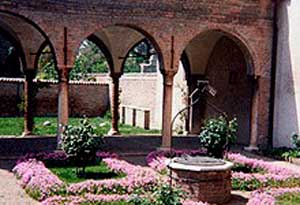 |
She was taken by a great desire to study theology, but her father forbade it as unsuitable for a child. Then Osanna had recourse to prayer. In response, Our Lady herself taught her and gave her lessons. In this way Ossana learned Latin and acquired a great mastery over Holy Scriptures. She was even able to quote the commentaries of the Church Fathers.
The paternal prohibition was eventually lifted. She died in 1505 and her body remains incorrupt after 400 years. It is presently in the Cathedral of Mantua.
Comments of Prof. Plinio:
Here we have a good example of both some marvelous facts from Blessed Osanna’s life, and a poor excerpt that makes it difficult to know her whole life. We learn that an admirable fact took place when she was 5- years-old, and then that she became a theologian, but we do not learn anything about her thinking or what she studied. We are told that her body is incorrupt, but the selection explains nothing about what made her a saint. It is very difficult to know her life with such data. They are brief flashes of light in the dark. I would like to know more about her life.
Many facts are missing, for example: Did she marry or enter a religious order? Was she persecuted for her love of God? Did she stand up to the religious authorities of the time who practiced simony, selling religious positions? Did she have extraordinary spiritual trials or spiritual consolations? Did she have other apparitions? All this I would like to know. I can understand that a selection cannot include all these points, but on the other hand, this excerpt makes it difficult for me to invite you to follow her example and become saints, which is the goal of these meetings.
Notwithstanding, the facts selected are quite beautiful and suggest some considerations that may interest you this evening.
You know that studies of theology and philosophy are very deep and demand a strong exercise of reason. These studies are normally appropriate for mature persons; the more mature the person, the more appropriate the study. This is the rule, but in the life of Blessed Osanna, you see something different.
Here you have a little girl of age five walking along the banks of a very beautiful river, the Po. I had the opportunity to enjoy the beauty of the Po as I traveled on a trip from Milan to Venice. So, the girl was admiring the view and an Angel appeared. A magnificent Angel who told her: “To enter Heaven it is necessary to love God very much: See how all created things sing His glory and proclaim it to men.” The meaning of the message is that God created all these things to be loved through them.
Why did an Angel appear to tell this to that child? How did the Angel go on to open the girls’ soul to that invitation to see God in creation? The child was probably already predisposed to consider the wonder of the panorama before her eyes. It is common among children who conserve their first innocence to take a position of admiration before the beauties of nature. Then, a splendorous Angel appears and becomes the most beautiful thing the child had before her eyes. He was so beautiful that the report, most probably based on her recollections, refers to him as splendorous.
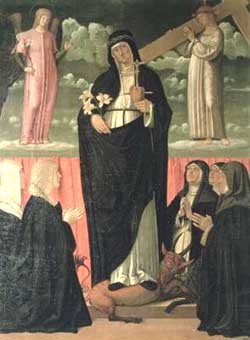
Blessed Osanna entered the Domican Third Order |
Then the Angel, moving in a kind of crescendo of beauties, raised her from this earth and showed her the celestial hierarchy, that is, the Angelic Hierarchy in Heaven, where the empty thrones of the fallen angels are gradually being filled by worthy men and women. Thus, he presented the most beautiful reality he could, which is the ensemble of the Heavenly Kingdom. After having shown her all that beauty, he told her to observe how all things created by God are beautiful and worthy of being loved. Thus, he came to the natural conclusion: Love them and love their Author, so that you also might go to Heaven and occupy your place there.
Thus God, through His Angel, invited that little girl to understand the splendor of His creation and His magnificence, which lay beyond the realm of the natural senses. He invited her to rise above those limits and focus her soul on the spiritual realities that are imperceptible to our senses, but are more intense than the material reality. He also showed her the Angel and the Angelic Hierarchy formed by spiritual beings. At the top of that hierarchy were Our Lady and, above her, the King of Kings, Our Lord Jesus Christ.
With this invitation, God was forming a person destined to reflection. Indeed, while the Angel was showing Osanna all those things, he was implicitly telling her to make an effort of intelligence and, through this, to know God. Here the Angel already indicated to her the way of her sanctification: If these things are so beautiful, how much more beautiful God is. Begin to meditate on these things.
We can imagine the scene. The river flows, tranquil and shimmering. Osanna is well-dressed in the style common in noble families of the time, not as the children are dressed today, but as a small woman, with a long skirt, a belt at her waist, her hair well arranged, and possibly with a flower in her hand. She is walking in a very civilized place, admiring both the river and the beautiful flora on the banks. Then, she sees the Angel. However, those around her see nothing. They observe that the girl’s features have begun to glow, and that she has fallen to her knees in prayer. The observers can hear her small, childish voice and realize that she is speaking with someone. What has happened? They are charmed by her spiritual grace and conclude that she is receiving a revelation. They probably sense in her a promise of God and the marvel of His work. Later they realize that thenceforth she began to reason as a mature, educated adult. These were possibly some consolations Osanna had.
But we can sense through the selection her fight with the world. She asked her father permission to study, and he refused. Naturally speaking, it is understandable. Her father thought it a strange request, since at the time it was very unusual for a woman - and especially a child - to be a theologian. Also, the father probably wanted her to have a good marriage to continue his family. All this is understandable, humanly speaking. But such reasoning must be set aside when God’s desire is manifested. The father knew that his daughter had experienced a miracle, but he said no to God, even though later he changed his mind.
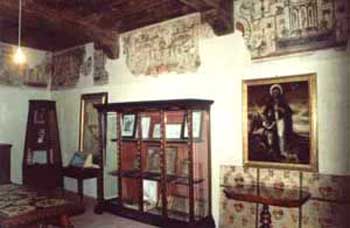
Above, relics of Blessed Osanna exposed in her family's palace. Below, her body remains incorrupt in the Cathedral of Mantua
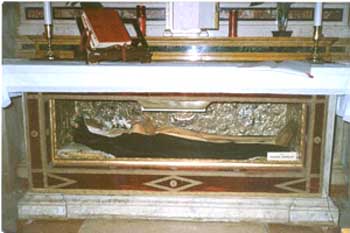
|
Notwithstanding, God had His way. Our Lady appeared to Osanna to teach her theology and give her all the lessons she needed. It is very charming. Our Lady gave her a solid knowledge of Holy Scripture. We can imagine that as Blessed Osanna grew and became a young lady, Our Lady would appear to her from time to time to teach her this or that point of theology that she needed to know to fulfill God’s plan for her. Later, she became a competent commentator on Scripture. We see the victory of Divine Providence.
In passing, I cannot resist wondering if she wrote about those apparitions and the teachings of Our Lady. Who among us would not like to know this book? The Catholic Church has so many treasures that this book could well exist and be forgotten among the manuscripts of a church library in Mantua. I would like to know, for instance, if in those teachings about Scripture, Our Lady explained some of the mysteries of the Apocalypse and told Blessed Osanna something about her coming Reign.
Blessed Osanna of Mantua is very little known in the Church. Why is that? I believe it is because after Liberalism infiltrated the Church, an index of forbidden saints, so to speak, was created. Only the hagiographies able to be presented under a distorted sentimental light were allowed to circulate. The others have been put aside and forgotten.
Wouldn’t it be very beautiful to have at the entrance of a Catholic University a large statue of Blessed Osanna of Mantua seated and taking notes as Our Lady teaches her classes?
Please, do not consider these comments about the life of Blessed Osanna of Mantua as complete, but rather as an invitation for you to go and look for more data on her life. If you do this, my comments have achieved their goal.


  | | Prof. Plinio Corrêa de Oliveira | |
The Saint of the Day features highlights from the lives of saints based on comments made by the late Prof. Plinio Corrêa de Oliveira. Following the example of St. John Bosco who used to make similar talks for the boys of his College, each evening it was Prof. Plinio’s custom to make a short commentary on the lives of the next day’s saint in a meeting for youth in order to encourage them in the practice of virtue and love for the Catholic Church. TIA thought that its readers could profit from these valuable commentaries.
The texts of both the biographical data and the comments come from personal notes taken by Atila S. Guimarães from 1964 to 1995. Given the fact that the source is a personal notebook, it is possible that at times the biographic notes transcribed here will not rigorously follow the original text read by Prof. Plinio. The commentaries have also been adapted and translated for TIA’s site.
|
Saint of the Day | Home | Books | CDs | Search | Contact Us | Donate

© 2002- Tradition in Action, Inc. All Rights Reserved
|
 |

|